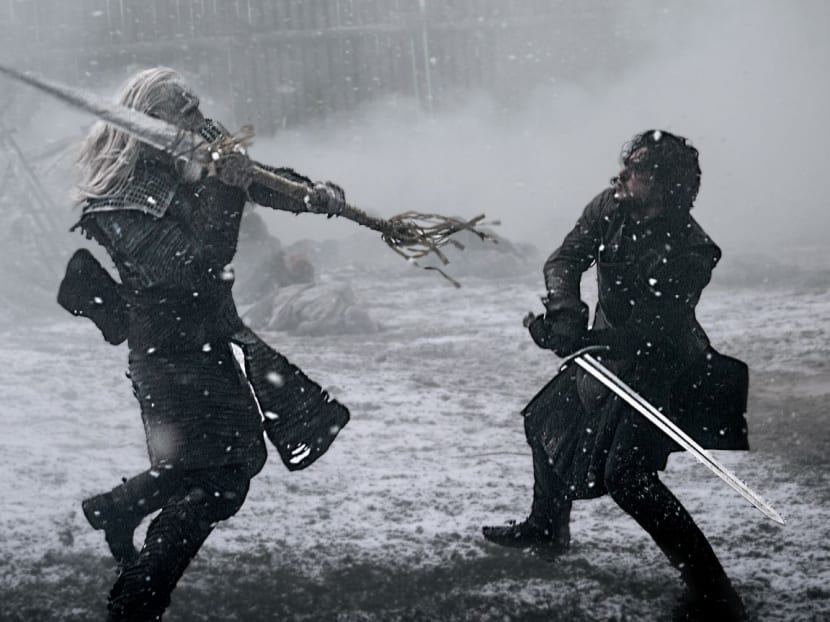Game Of Thrones and the rise of primetime violence
LOS ANGELES — As Game Of Thrones swept the Emmys to become the most awarded narrative series in history, the TV world remarked approvingly that its exceptional production values were being given due recognition.

Jon Snow (right) battles a White Walker in this scene from Game Of Thrones. Photo: HBO
LOS ANGELES — As Game Of Thrones swept the Emmys to become the most awarded narrative series in history, the TV world remarked approvingly that its exceptional production values were being given due recognition.
But critics say its success is emblematic of an increasingly disturbing predilection in television for intense violence, with directors swapping old-fashioned scares for the kind of gut-churning gore once confined to R-rated movies.
Since its debut in 2010, the fantasy epic — which has now hauled in 38 Emmys in total, including Best Drama for two years running — has been the target of criticism for senseless violence and, more controversially, its pervasive use of rape as a dramatic device.
Over the years, the show has brutalised women, killed children, depicted graphic sex and had its characters hacked, stabbed, flayed, poisoned, decapitated, burned alive, eye-gouged and eviscerated — all in glorious, close-up detail.
News magazine The Atlantic described the show’s tendency to “ramp up the sex, violence, and — especially — sexual violence” in George RR Martin’s source novels as its “defining weakness”.
Leigh Whannell, who created and starred in the Saw and Insidious horror franchises, said the creep of violence into TV was the inevitable result of the small screen usurping cinema as the go-to medium for quality entertainment.
“As the broadcasters open up, there’s places like Netflix, Hulu and all these different streaming services and more places to show material, the hunger for material is increasing,” he told AFP.
“I think the rules of what you can and can’t show are widening. A place like Netflix can essentially show whatever they want. They don’t have to stick to the rules of an ABC or a CBS.”
The blood and guts clearly isn’t a turn off for fans of Game Of Thrones, which has grown its audience in the US — where it is shown on premium cable network HBO — to more than 25 million, and is breaking records across the world.
Zombie thriller The Walking Dead, meanwhile, claims the highest total viewership of any series in cable television history.
A host of other violent cable and satellite shows, from FX’s The Strain and Showtime’s Penny Dreadful to Cinemax’s The Knick have all been ratings successes — despite the blood and guts. And network shows like NBC’s Hannibal demonstrate that violence isn’t confined to cable.
A 2013 study by the United States’ Parents Television Council stated that “some of the most violent TV-14-rated shows on broadcast TV have similar levels and types of violence as TV-MA-rated (Mature Audience) cable TV shows”.
“I’ve always been of the view that if you don’t like it, don’t watch. If someone doesn’t like ‘Game of Thrones,’ they can switch off,” Whannell told AFP.
There is some evidence of a correlation between small screen and real-life violence, although proof of a causal link has always been patchy.
Psychologists George Comstock and Haejung Paik analyzed more than 200 studies published between 1957 and 1990, concluding that fictional violence might have a short-term effect on the mindset of susceptible viewers.
Six American medical organisations reviewed the research in 2000 and issued a joint statement to Congress concluding that “viewing entertainment violence can lead to increases in aggressive attitudes, values, and behaviour, particularly in children.”
Mike Flanagan, the director of Universal’s upcoming horror film Ouija: Origin Of Evil, said intense violence, gore, torture and rape have been much more accepted on primetime TV since the turn of the century.
“Our tolerance has been challenged and there’s only one direction for those things to go. The more we see, and the more content that is put out there in the marketplace, the more gradually desensitised we become,” he told AFP.
“In order to get people’s attention, there’s this gravity toward pushing the envelope even further.”
But this isn’t necessarily a bad thing, he argued, describing television as a provider of a “safe space” in which people are able to reflect on the darker side of human nature.
“One of the positives is that at least we get to explore that side of ourselves in a relatively safe environment and in an environment where we can turn off the TV or where the lights come on after the movie is over,” Flanagan said.
Meanwhile, actress and producer Naomi Grossman, who starred in two seasons of FX’s American Horror Story, said she wants to see “more sex and less violence” on TV.
“I just think Americans have it all screwed up, to be honest,” she told AFP.
“It’s so strange to me that you can’t show a nipple, can’t show breastfeeding, yet you can see someone’s neck get slashed.” AFP








